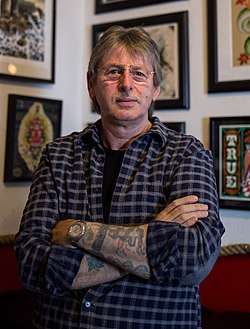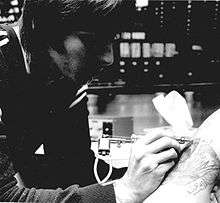Manfred Kohrs
Manfred Kohrs (born January 24, 1957) is a German tattooist and conceptual artist, who has been tattooing since 1974. He was a student of Horst Streckenbach ("Tattoo Samy") (August 5, 1926 – June 27, 2001). Together they developed the barbell piercing in 1975.[1][2][3][4] Kohrs invented a rotary tattoo machine with main part an electric motor and an ink reservoir.[5] In 1977 Kohrs founded the first German Tattoo Artist Association.[6] He gave up tattooing in 1990 and began studying economics. Since completing his economics degree in 1996, he has served as tax consultant and Certified Public Accountant (GER).
Manfred Kohrs | |
|---|---|
 | |
| Born | January 24, 1957 |
| Occupation | Tattooist; Art-Painter; Master of Economics (USUE) |
Biographical and career information
Kohrs was born in 1957 and grew up in Hanover, Germany; from 1968 to 1974 he plays Rugby in Hanover-List.[7] From 1971 to 1973 he trained as a mechanic at the Deutsche Grammophon Gesellschaft and subsequently completed his military service at the Aufklärungsgeschwader 51 of the German Air Force.
At the age of twelve he purchased his first tattoo and in 1975 he was tattooed by Herbert Hoffmann. The integrated nationally recognized tattoo artist Horst Streckenbach took Kohrs in 1975 as a master student.[8] In 1976, he began tattooing professionally. In 1977 he opened his own studio in Hanover[9] and in 1978 he built a new rotary tattoo machine.[10] It was invented by Samuel O'Reilly and subsequent improvements were made by the tattoo artists over the years.[11] Kohrs tattooed Rio Reiser, Klaus Meine, Rudolf Schenker and other several notable musicians, artists and celebrities of the time.[12]
In 1977 Kohrs was an early member of The National Tattoo Club of the World[13] which was renamed 1984 to the National Tattoo Association, (N.T.A.). In the same year Kohrs was the founder-member No. 25 of the European Tattoo Artists Association.

In 1977, Kohrs invited all commercially registered tattooists in Germany to an information meeting in Hanover. "At that time there were throughout the country, only 14 self-employed tattoo artist."[14][15]
The purpose of this meeting were the establishment of a national association, and to introduce technical and hygienic standards. At that time, Kohrs and Streckenbach were the only German tattoo artists who used an autoclave for the sterilisation of equipment.[16]
Kohrs attended the first National Convention at the Cosmopolitan Hotel in Denver, Colorado from 23–25 March 1979.[17] He made a slide presentation of tattooed people with Tattoo Samy.[13] The speakers on the convention were Terry Wrigley, Peter Tat 2 Poulos, Diane Poulos, Don Ed Hardy, Bob Shaw (who spoke about the importance of using autoclaves and hygiene), Big Walt Kilkucki, Painless Jeff Baker, Dave Yurkew, Arnold Rubin and Jan Stussy.[13] Kohrs, Streckenbach and Terry Wrigley (president of E.T.A.A),[18] were present in October 1980 at the first German Tattoo Convention at Frankfurt. Kohrs gave up tattooing in 1990 and began studying economics in Hanover, Hamburg and at Ural State University of Economics. Since completing his economics degree in 1996, he has served as tax consultant and lecturer in economics at a private academy.[19]
In 2016, after more than 45 years, Kohrs appears first again in the tattoo scene, he gave a detailed interview to Stadtkind Hannovermagazin[20] and the Tattoo Kulture Magazine.[21] In December 2016 he visited the exhibition Nailed to the Cross by PMA Tattoo Hanover[22] and November 2017 the 10. tattomenta Kassel.
From November 2019-May 2020, the Museum für Hamburgische Geschichte has been showing a special exhibition on Christian Warlich with a section on Streckenbach and Kohrs.[23]
Research work
Manfred Kohrs is founder and since 1997 chairman of the board of the Institut für deutsche Tattoo-Geschichte, Ole Wittmann executive board member and research director.[24] The non-profit association Institut für deutsche Tattoo-Geschichte e.V. (IDTG) is a close partner of the research and exhibition project Nachlass Warlich. The purpose of the IDTG is to promote science, research, art and culture as well as education and mediation. Since an interdisciplinary approach to tattoo research is of great importance, scientists from different disciplines should be supported in their research on tattoos. The purpose of the statutes is realized by organizing scientific events and research projects on German tattoo history in an international context. The results are to be published in publications and other media in order to make them accessible to a broad public.[25]
Since March 2018, Kohrs has worked as a research associate in the estate project Nachlass Warlich. Since December 2015 Ole Wittmann is a postdoctoral scholarship holder of the Hamburger Stiftung zur Förderung von Wissenschaft und Kultur (Hamburg Foundation for the Promotion of Science and Culture) working on a research project on the estate of the German tattooist Christian Warlich (1891–1964) in cooperation with the Stiftung Historische Museen Hamburg/Museum für Hamburgische Geschichte.[26]
Documents
 National Tattoo Club of the World, issued from „Philadelphia“ Eddie Funk,[27] 1977.
National Tattoo Club of the World, issued from „Philadelphia“ Eddie Funk,[27] 1977. European Tattoo Artist Association, issued from Terry Wrigley 1976.
European Tattoo Artist Association, issued from Terry Wrigley 1976. European Tattoo Artist Association, issued from Terry Wrigley 1977
European Tattoo Artist Association, issued from Terry Wrigley 1977 first Tattoo-Meeting Frankfurt 1980.
first Tattoo-Meeting Frankfurt 1980.- membercard "Kunstverein" Hannover 1981, signed by Kohrs
Art and design
In 1975, on the German Norddeutscher Rundfunk television show Nordschaumagazin,[28] Kohrs met the well-known German artist Prof. Timm Ulrichs.[29] In 1981, Ulrich was approached about Streckenbach to Manfred Kohrs[30] in Hanover to be tattooed as part of an art project, the words "THE END" refers to an eyelid.[31] In 1981 Streckenbach created that conceptual art-project with Ulrichs.[32]
"Once the moment has finally come when the curtain falls for good, when my eyesight disappears and my eyes are closed for eternal rest, the pulled-down eyelid will reveal as a last, surprising theatrical coup the final punch line, in my view quite memorable: the "Last Picture Show", presented with a weeping and a laughing eye, with a wink, the final performance of a life and a life performance intended to be spectacular and dramatic." Timm Ulrichs
[33]
In the years 1977 to 1981 created Kohrs some individual projects with the topic of tattoos.[34] From 1978 Kohrs drew cartoons for various magazines.[35] Since 2011 Kohrs is President of the art association in Wedemark, Germany.[36]
The Tattoo Machine Manfred Kohrs 1978 K was in 2015 exhibited in a German Art museum.[37]
Publications
- Manfred Kohrs and Heiko Gantenberg: Lyle Tuttle – Tattoo-Pioniere im Fort Notch, in: Tattoo Kulture Magazine 38, May/June 2020, p 38–47.
- From the Past – First US-Tattoo Convention Houston/Texas 1976, in: Tattoo Kulture Magazine 37, March/April 2020, p 88–89.
- Die Tattoo-Forscher, in: Tattoo Kulture Magazine 35, issue 6, November/December 2019, p 22–28.
- Streckenbach, Mentor der Tattoo-Jugend, in: Tattoo Kulture Magazine 34, issue 5, September/October 2019, p 26–32.
- Manfred Kohrs – Geschichte machen, Geschichte schreiben, in: Paul-Henri Campbell: Tattoo & Religion. Die bunten Kathedralen des Selbst. Wunderhorn, Heidelberg 2019, p 86–95.
- Hüter des verlorenen Schatzes – Herry Nentwig, in: Tattoo Kulture Magazine 33, issuet 4, July/August 2019, p 22–32.
- Der vergessene Pionier – Horst H. Streckenbach. Tattoo-Samy, in: Tattoo Kulture Magazine 32, issue 3, May/June 2019, p 28–40.
See also
Selected bibliography
- Björn Brocks: Abnorm (Hannover-Krimi). Niemeyer, Hameln 2011, ISBN 3-8271-9452-0.
- François Chauvin: Mondial du tatouage Hors Collection Loisirs. Hachette Pratique 2018, ISBN 2-01-625602-8, p. 15.
- Samuel M. Steward: Bad Boys and Tough Tattoos. Routledge London & New York 1990, ISBN 0-918393-76-0.
- Margot Mifflin: Bodies of Subversion. powerHouse Books 2013, ISBN 1-576-87692-6.
- Caroline Rosenthal, Dirk Vanderbeke: Probing the Skin: Cultural Representations of Our Contact Zone. Cambridge Scholars Publishing 2015, ISBN 1-443-87518-X.
- Paul-Henri Campbell: Tattoo & Religion. Die bunten Kathedralen des Selbst. (Interviews) p. 86 – 95: Manfred Kohrs – Geschichte machen, Geschichte schreiben, Heidelberg 2019, ISBN 978-3-88423-606-2.[38]
References
- Hannoversche Allgemeine Zeitung, Ausg. Ost, S.2, 23. April 1981, Tätowieren – eine besondere Kunst / Manfred Kohrs (in German)
- tattoo-manufacturer
- Marcel Feige: Das Tattoo-und Piercing Lexikon, ISBN 3-89602-209-1, S. 283
- "Inspiration". ezetraining.com.au. Archived from the original on 2016-03-04. Retrieved 2016-12-13.
- reinMein die überlokale Zeitschrift: Das Tattoo-Kunsthandwerk – eine Technik, die unter die Haut geht (in German)
- Offenbach-Post, Nr. 180, 1984 (in German)
- Vereinsnachrichten des S.C. Germania List, Dezember 1971, Heft Nr. 33, S. 10
- Cellesche Zeitung, 5. Mai 1984, S. 23 (in German)
- Stadtkind Hannovermagazin, Ausgabe Juli 2016, S. 44–49: Nadelstiche. Im Interview:Manfred Kohrs.
- Tattoo Nation - Tattoo Magazine, Issue # 1, July 10 2014, Page 35/64
- Tattoo Nation Nepal's first Tattoo Magazine - July 2014, Issue #1, Page 35.
- National Tattoo Magazine, June–July 1978, S. 9 work by Manfred Kohrs of Hannover West Germany
- "History - Official National Tattoo Association Website". nationaltattooassociation.com. Archived from the original on 2012-09-16. Retrieved 2016-12-13.
- Frank-Peter Finke-Oltmanns, Tattoos in Modern Societies, dissertation 1996.
- German Federal Social Court (Bundessozialgericht), Case No.: B 3 KS 2 / 07 R Case of 28 February 2007
- Hannoversche Allgemeine Zeitung, Ausg. Süd, S.3, 24. April 1986, Manfred Kohrs - "Hautbilder" (in German)
- Mississippi Gulf Coast's Observer, September 2012, Volume 13, Issue 3, p. 36
- tattoo archive Terry Wrigley Archived 2010-09-04 at the Wayback Machine
- Caroline Rosenthal, Dirk Vanderbeke: Probing the Skin: Cultural Representations of Our Contact Zone, p. 177.
- Stadtkind Hannovermagazin, Issue Juli 2016, page 44-49: Nadelstiche. Im Interview: Manfred Kohrs.
- Sabrina Ungemach in Tattoo Kulture Magazine Issue 22, 2017, page 44–52.
- Tattoo Kulture Magazin: Nailed to the Cross by PMA Tattoo Hanover. #18 2016, p. 70-71.
- shmh.de: TATTOO-LEGENDENChristian Warlich auf St. Pauli 27. November 2019 bis 25. Mai 2020
- AG Hannover; VR 120208
- official website
- Kilian Trotier (April 19, 2017). "Geschichte mit gravierenden Folgen". Die Zeit.
- About Crazy Philadelphia Eddie
- NDR-Information Service - Number 0007750128, NDR HH Card 2008/12/12 (1, 2)
- NaNa Hannover, Nr.36/37, -Portrait eines Künstlers- Manfreds Bilder fahren Straßenbahn, December 23. 1982.
- Paul-Henri Campbell: Tattoo & Religion. Das Wunderhorn, Heidelberg 2019, ISBN 978-3-88423-606-2, p 90.
- Dieter Fietzke und Hubertus Müll, 1990/97 Foto: Foto-Hoerner, Hannover © VG Bild-Kunst, Bonn 2010
- Süddeutsche.de GmbH, Munich, Germany. "Ausstellung: Timm Ulrichs - Wie jeder Clown, so ist - Kunst - Kultur - Süddeutsche.de: THE END, Augenlid-Tätowierung, 1970/16. Mai 1981". Archived from the original on 2010-12-23. Retrieved 2016-12-13.CS1 maint: multiple names: authors list (link)
- Süddeutsche.de GmbH, Munich, Germany. "Ausstellung: Timm Ulrichs - Wie jeder Clown, so ist - Kunst - Kultur - Süddeutsche.de". Archived from the original on 2010-12-23. Retrieved 2016-12-13.CS1 maint: multiple names: authors list (link)
- "GAT 2016 - Grüße Aus Tätowierungen in der Willner Brauerei". kunstleben-berlin.de. Retrieved 2016-12-13.
- National Tattoo Magazine, June–July 1978, S. 13 cartoon by Kohrs
- registered in Hanover court, VR 120263
- kulturringc.de. Skin Stories
- Verlag Das Wunderhorn. "Tattoo & Religion · Verlag Das Wunderhorn". Archived from the original on 2019-02-09. Retrieved 2019-02-08.
External links
- The Tuscaloosa News - 25. Dez. 1978
- Streckenbach/Kohrs Tattoo Machine (German)
- tattoo-bewertung.de (German)
- Tattoo Nation - Tattoo Magazine, Issue # 1, July 10 2014, Page 35.
- SparkFun 3D Printed Tattoo Machine (Manfred Kohrs Rotary Tattoo Maschine from 0:23 to 0:36)
- Rotarymaschine 1978 K (Film Ole Wittmann PhD, Stiftung Historische Museen Hamburg).